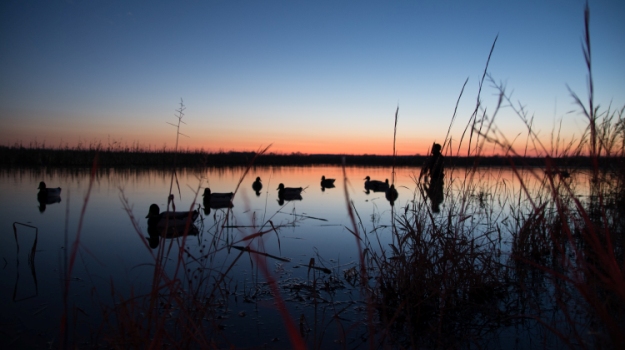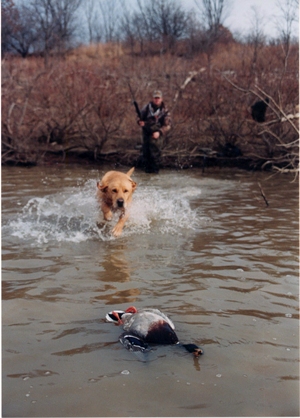
My friends often ask me, “Brooks, when I want to hunt on public waterfowl areas, what do I need to look for there?” I explain, “Search for balls of feathers and shotgun shells. If you see them on the place you think you want to hunt, don’t hunt there. More than likely, someone has shot ducks from that spot the day or two before you’ve arrived. But when you see a spot that has individual feathers on the water, and you don’t see any sign of other hunters, that’s the places you need to hunt.”
The 15 men I hunt with and I were so successful on the second day of waterfowl season, because we decided at 9 a.m. on opening day that we probably weren’t going to be able to take any ducks on the place where we’d set-up. So, we divided up into two groups and started scouting for the next day of hunting.
Another effective way to scout for ducks on public waterfowl areas is to scout in the spring. In the spring, our area usually has a lot of rain, and the water in these waterfowl areas often will be at their highest levels, especially in Arkansas. Most of the time, we can find flooded-timber regions with plenty of oaks where ducks should be during the fall and winter months. Scouting during duck season can be difficult, if you can’t go into these public-hunting areas in the afternoon. So, if you hunt until noon during the season, you don’t have any time to scout. Places that usually fill-up with water during a spring rain also will fill-up with water during the fall rains before and during duck season. So, spring is a productive time to scout public land for waterfowl.
Why Walk In
A friend of mine who manages the White River National Wildlife Refuge said, “Brooks, if these duck hunters in Arkansas can’t get to a place to hunt in a boat, they're not going to hunt here.” That statement is about 95 percent correct on all public-hunting areas. That’s the reason we walk in to hunt. We've also learned that very few people will walk around the edges of the water to look for places where ducks will hold during the season.
 Arkansas differs from Mississippi, because Mississippi has so few public waterfowl-hunting areas that most waterfowl hunters in Mississippi walk into the woods, backwaters of rivers, creeks and ponds that hold ducks. Our group was fairly accustomed to walking to a place to take ducks. So, we took those techniques that we used in Mississippi over to Arkansas where most public-land hunters hunt from boats.
Arkansas differs from Mississippi, because Mississippi has so few public waterfowl-hunting areas that most waterfowl hunters in Mississippi walk into the woods, backwaters of rivers, creeks and ponds that hold ducks. Our group was fairly accustomed to walking to a place to take ducks. So, we took those techniques that we used in Mississippi over to Arkansas where most public-land hunters hunt from boats.
Our group has about 15 hunters who walk in from the bank out to flooded timber areas to take ducks in Mississippi and in Arkansas. Early in the season, we feel we’re much more effective if we all call, even if some hunters only can do quacks or a little bit of chatter. We’re usually working big flocks of ducks. So, we want to sound like a big flock of ducks in the flooded timber feeding.
My nickname in our group is the Hunt Boss, because I call the shot when we’re hunting together. Each time we go hunting, especially if we’re hunting with new hunters, I usually give a safety orientation. If we have a large group that’s spread out over a large area, I explain that I will call the shot, or the hunter on the other end from where I'm standing will call the shot, depending on where we think the majority of the ducks will land.
Another question I'm often asked is, “When you're hiking in along the shoreline to a public- hunting area and possibly wading out from the bank to standing timber, how many decoys do you carry to put out?” Early in the season, we prefer to hunt larger duck holes than we hunt later in the season, because the trees will be leaved-out. Seeing decoys can be much more difficult for the ducks. So, we generally put out a bigger decoy spread early in the season than later in the season.
We pack different types of decoys for different types of hunting situations. Generally, I carry about 3 dozen lightweight blowup type decoys. I easily can pack that many decoys in a pack, and I can carry my gun and the other equipment I’ll need for a successful hunt. All the hunters who hunt with us carry backpacks when we’re walking into an area. That way, we can carry in plenty of decoys and other essentials for a good waterfowl hunt. Most of our hunters will try to carry different types of decoys. Early in the season, each hunter often will carry four to six dozen decoys to put-out on public lands. A friend and I hunted about midway through the season, and we only carried about 2 dozen decoys each. We had two other hunters, and we harvested 16 mallards by 8:30 a.m. The decoys I like are made by Cherokee Sports and are extremely lightweight.
Day 2: How to Dodge Hunting Pressure on Public Land Waterfowling Areas
Tomorrow: What to Do When Hunters You Don’t Know Move into the Spot You’re Hunting




























